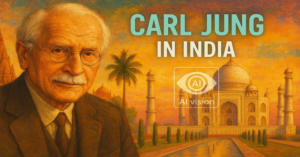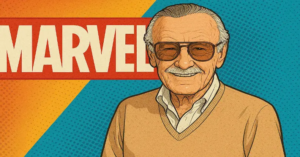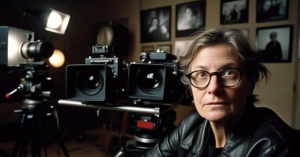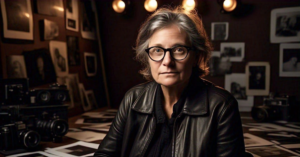Greta Thunberg: Climate Icon, Activist & Global Leader
Greta Thunberg: The Teen Who Took On the World

The Whisper That Became a Roar
On August 20, 2018, a slight 15-year-old girl sat alone on the cobblestones outside Sweden’s parliament building. Her hand-painted sign read “Skolstrejk för Klimatet” (School Strike for Climate). Then Greta Thunberg solitary vigil began. After Sweden’s hottest summer in 262 years—a season of heatwaves and wildfires that screamed climate emergency. Here “I want to feel safe,” she had written months earlier in a winning essay for Svenska Dagbladet. And “How can I feel safe when I know we are in the greatest crisis in human history?”
Within weeks, her whisper ignited a global roar. By September 2018, what started as a one-girl protest exploded into the #FridaysForFuture movement—millions of young people abandoning classrooms to demand planetary salvation. Completely, this is the story of how an “ordinary” teenager diagnosed with Asperger’s syndrome weaponised her difference. Turned family trauma into global action. And forced world leaders to confront an inconvenient avalanche.
The Making of a Movement: From Darkness to Defiance
A Childhood Stolen by Data
For the first time, Greta encountered climate change at age eight. While her classmates absorbed fairy tales, she consumed graphs of carbon emissions and species extinction rates. Then dissonance haunted her: “If the oceans die, we die. Why was no one acting like this was an emergency?”. By 11, the weight of impending collapse triggered severe depression. So she stopped speaking, eating, and attending school. Her opera singer mother, Malena Ernman, recalled: She cried on her way to school. But slowly disappearing into darkness .
Here diagnosed with Asperger’s syndrome, OCD, and selective mutism, Greta found her voice through crisis. That’s why she called her neurodivergence a “superpower”: “If I would’ve been like everyone else, I wouldn’t have started this school strike”. Best of all, laser focus on climate science became her lifeline. And she weaponised it at home first. For two years, she bombarded her parents with data. Then demanding that they become vegan, upcycle, and abandon air travel. Her ultimatum cut deep: “You are stealing my future” .
The Strike That Shook the World
Armed with leaflets citing 30 scientific sources, 15-year-old Greta launched her strike despite parental resistance. Here Svante Thunberg confessed: “We said, ‘If you do this, you’re alone.’ So we thought social media would destroy her” . On Day 1, journalists ignored her. On Day 3, a stranger gave her vegan pad thai—a moment her father calls mystical: “She changed. In her life, she could do things she’d never done before” .
Then, a viral Instagram post. Then hundreds. Then thousands. By election day, she wasn’t alone. Then #FridaysForFuture hashtag was born. And students from Brussels to Sydney joined the sit-ins. Reaction of Greta’s ?. When one person joined me on Day 2, I knew, I could make a difference .
Greta Thunberg : The Rapid Growth of Fridays for Future
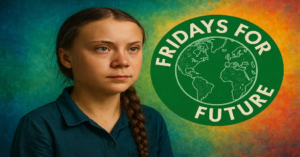
| Date | Event | Scale |
|---|---|---|
| August 20, 2018 | Solo strike outside Swedish Parliament | 1 protester |
| September 2018 | First global climate strike | 100+ cities |
| March 2019 | Coordinated multi-city marches | 1.5 million+ protesters |
| September 2019 | Global Climate Strike | 4 million+ across 163 countries |
Greta Thunberg : The Speeches That Slayed Giants
“Our House Is on Fire”
Here oratory of Greta’s fused scientific precision with raw moral fury. At Davos 2019, she discarded hope for panic: “I want you to act as if your house was on fire. Because it is”. In the EU Parliament, she branded climate inaction “the greatest failure of human history”. Her style was deliberate: monotone delivery, facts over flair. So that eyes locking onto leaders like scalpels.
“How dare you!” – The UN Speech Heard Round the World
In the month of August, 2019, Greta sailed emissions-free across the Atlantic (a 15-day voyage) to confront world leaders at the UN Climate Action Summit. So her 4-minute speech detonated like a moral grenade :
“You have stolen my dreams and my childhood with your empty words… We are in the beginning of a mass extinction, and all you can talk about is money and fairy tales of eternal economic growth. How dare you!”
Here philosopher Peter Singer called it “the most powerful four-minute speech I’ve ever heard.” Sarcastically Donald Trump tweeted: “She seems like a very happy young girl”. Prompting Greta to update her Twitter bio: “A very happy young girl looking forward to a bright and wonderful future”. Then the phrase “How dare you” became an anthem, remixed into death metal songs and DJ Fatboy Slim tracks .
Greta Thunberg : Anatomy of a Viral Speech
| Element | Content | Impact |
|---|---|---|
| Opening Hook | “This is all wrong. I shouldn’t be here” | Framed as a stolen childhood |
| Moral Charge | “You have stolen my dreams” | Personalized intergenerational injustice |
| Scientific Proof | “420 gigatons of CO2 budget left (2018)” | Undercut political vagueness with data |
| Call to Arms | “We will never forgive you” | Mobilized youth solidarity |
The Greta Effect: Ripples and Backlashes
Mobilizing Millions
Across 7500 cities by 2023, Fridays for Future had mobilized over 13 million strikers. So compassionately, the “Greta effect” measurable:
- Policy Shifts: The EU pledged to cut emissions 55% by 2030 after her Strasbourg address .
- Cultural Wake-Up: David Attenborough credited her: “You’ve aroused the world” .
- Neurodiversity Advocacy: Autistic youth found a hero. “Many in our movement are autistic,” Greta noted. “They can’t look away from truth” .
Greta Thunberg Fury of the Status Quo
Yeah own way, Greta’s rise magnetised vitriol:
- Brazil’s President Jair Bolsonaro dismissed her as a “brat”.
- Vladimir Putin patronised her as “poorly informed”.
- Andrew Tate’s trolling (“I have 33 cars”) backfired when Greta’s sarcastic reply went viral, leading to Tate’s arrest.
Through it all, her compass held true. Then arrested for blocking oil facilities. But she declared, “We are the necessary troublemakers.”
The Woman Behind the Icon: Humanity in the Hot Seat
Greta Thunberg Family, Fear, and Fortitude
Behind that Greta’s steeliness lies a family transformed. Her father, Svante, joined her sail to New York “not to save the climate—to save my daughter”. Her mother abandoned international opera tours, adopting near-veganism. Yet Greta refused guilt: “It was their choice. I just gave them information”.
Greta Thunberg Growing Up on the Frontlines
In 2023 majorly, graduating high school didn’t slow her. Instead, Greta evolved:
- Broadening Activism: Championed Ukraine, Palestine, and Indigenous rights .
- Direct Action: Joined coal mine blockades, declaring civil disobedience essential when “leaders behave like children” .
- The Climate Book (2023): Curated essays from 100 experts, proving her commitment to solutions .
Greta Thunberg Legacy: The Child Who Refused to Stay Small
Here one of the most, she redefined power. As well as most cases, no office, no fortune, no weapons—just a girl who refused to beg. Her only way of genius lay in inverting the narrative: children became the adults in the room.
When critics sneered at her “anger”. Then she retorted, “What is anger but care in overdrive?”. When they dismissed her as a puppet. Her TEDx talk clarified, “I don’t want your hope. So I want you to panic and act”.
Today, as wildfires rage and glaciers weep. Her warning echoes: “The world is waking up. Change is coming—whether you like it or not”. In that civilisation hypnotised by growth, Greta is the alarm clock we cannot snooze. Her greatest lesson?
“No one is too small to make a difference.”
— Those words that launched a million strikes, and maybe, a future.
Epilogue: The Ordinary Superpower
On January 3, 2023, Greta turned 21. No fanfare, no retreat. Still striking, still speaking truth to trembling power. To her parents, she’s finally “an ordinary child”—dancing, laughing, healing . To Earth’s children, she’s the extraordinary voice that taught them: In a world on fire, “different” is the superpower that lights the way.

